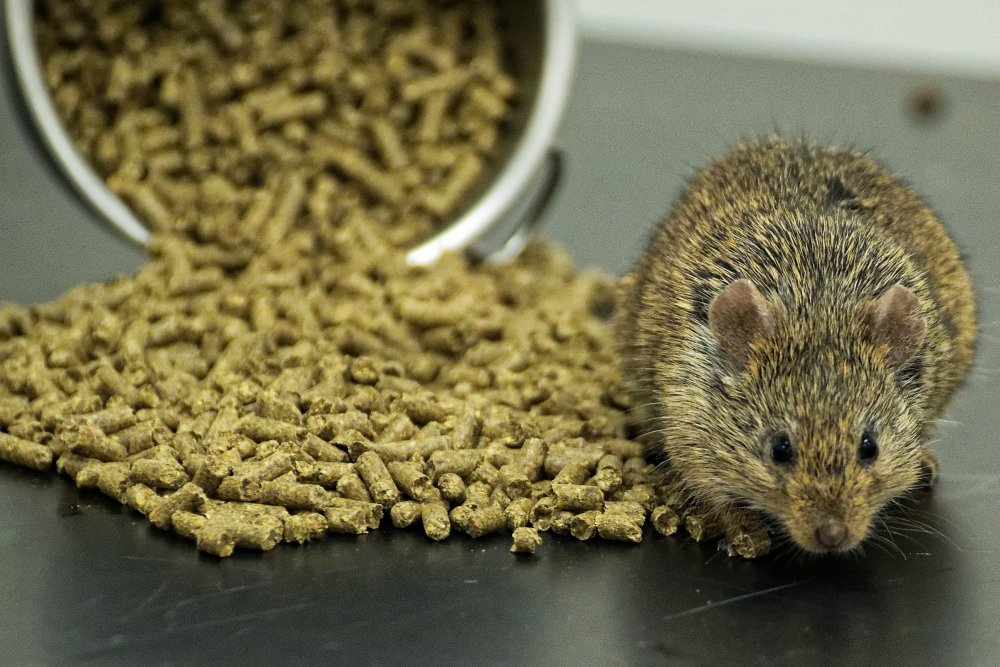
A Better Model for Type 2 Diabetes
Researchers have assembled the first reference genome for the Nile rat — a kind of genetic template of this species that may be used for laboratory and clinical studies. The hope, according to UC Santa Barbara researcher Huishi Toh, is that it will be useful for those who investigate Type 2 diabetes and neurological disorders associated with a disrupted diurnal rhythm. The Nile rat is prone to diet-induced diabetes, and exhibits a clear diurnal pattern, unusual in rodents.
“It was a risk, and it took a long time,” said Toh, an assistant project scientist in cell biologist Dennis Clegg’s lab, continuing work that she started in the lab of UCSB emeritus professor of biology Dr. Jamie Thomson. “But when you’re assembling a new genome, you have to be aware of various sequencing errors.” Toh is the lead author in a paper that appears in BMC Biology.
‘Highly Complete Genome’
Model organisms are among our best aids in understanding some of our more complex diseases, and are often chosen for, among other things, their similarity to humans in some physical or genetic way. Such is the case with the house mouse and the brown rat, which are used to investigate the underlying genetics of some human diseases.
But it’s not a one-size-fits-all situation, particularly in the case of Type 2 diabetes, which affects more than 35 million individuals in the U.S. today. While researchers have been using common laboratory mice and rats to improve our understanding of the disease, tracing the development of diet-induced diabetes and its complications in the more typical rodent models has not been very rewarding.
“A major problem in modeling Type 2 diabetes is that laboratory rats and mice are not particularly susceptible to diet-induced diabetes,” Toh said. “Obesity-induced mice are in fact models of pre-diabetes, and genetic or chemical manipulation are often required to push these conventional rodents to develop diabetes and its complications, thus not mimicking the natural progression of Type 2 diabetes in humans.”
Over the last couple of decades, however, the Nile rat has emerged as a potential model for Type 2 diabetes. Hailing from the grasslands of sub-Saharan Africa, these rodents live on a high-fiber, low carbohydrate diet, unlike their more city-dwelling cousins who may have already adapted to a more human-like high carbohydrate diet. Laboratory food, it turned out, was hypercaloric for the Nile rats, and they would, like humans, spontaneously develop diet-induced diabetes.
Previously, the Thomson lab demonstrated that the Nile rat could develop diabetic retinopathy with key vision loss features — similar to humans — and lacking in other rodent models, thus solidifying the Nile rat as a model of well-developed Type 2 diabetes. What was missing was a reference genome, a genetic sequence that represents the animal in general and can serve as a touchstone or starting point in the search for genetic variations that could indicate susceptibility to certain diseases and other gene-related conditions. In partnership with the Vertebrate Genome Project, Morgridge Institute for Research and University of Southern California, the international collaboration of researchers assembled a “highly complete and highly contiguous” genome.
Among the things they noticed in comparing the Nile rat genome to the genome of the laboratory mouse was that the Nile rat had fewer copies of a gene that encodes for the carbohydrate processing enzyme called amylase, possibly reflecting the lack of adaptation of high-starch diets.
“We think that the Nile rat is not adapted to eat high carbohydrate foods, which makes sense because they normally eat grass in Africa,” Toh said. “I think this is why they are so susceptible to diabetes.” Conversely, laboratory mice — having lived near and around humans — had more copies of this gene, a sign of evolutionary adaptation to their environment.
In fact, Toh said, one of the benefits of having a reference genome is that it becomes possible to witness the genetic consequences of environmental impact. “Currently, we are using this reference genome to study transcriptomic changes relevant to the initial development of diet-induced diabetes,” she said, “and eventually we hope to take a look at the epigenetics as well.”
This study was supported by the Garland Initiative for Vision, funded by the William K. Bowes Jr. Foundation.



